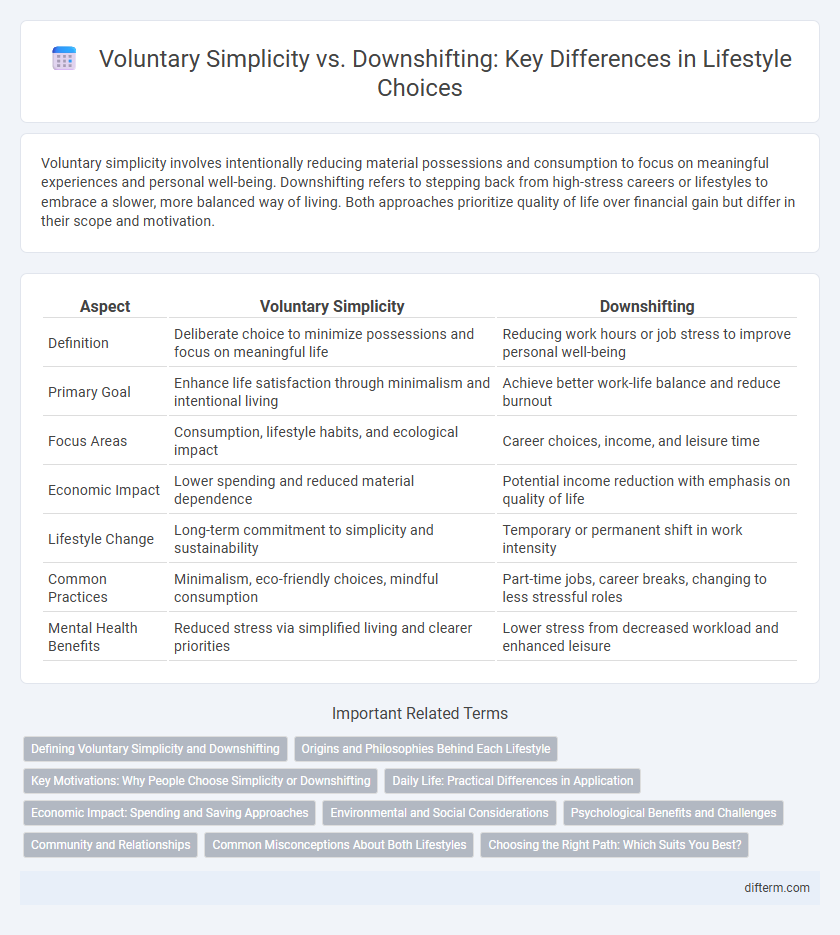Voluntary simplicity involves intentionally reducing material possessions and consumption to focus on meaningful experiences and personal well-being. Downshifting refers to stepping back from high-stress careers or lifestyles to embrace a slower, more balanced way of living. Both approaches prioritize quality of life over financial gain but differ in their scope and motivation.
Table of Comparison
| Aspect | Voluntary Simplicity | Downshifting |
|---|---|---|
| Definition | Deliberate choice to minimize possessions and focus on meaningful life | Reducing work hours or job stress to improve personal well-being |
| Primary Goal | Enhance life satisfaction through minimalism and intentional living | Achieve better work-life balance and reduce burnout |
| Focus Areas | Consumption, lifestyle habits, and ecological impact | Career choices, income, and leisure time |
| Economic Impact | Lower spending and reduced material dependence | Potential income reduction with emphasis on quality of life |
| Lifestyle Change | Long-term commitment to simplicity and sustainability | Temporary or permanent shift in work intensity |
| Common Practices | Minimalism, eco-friendly choices, mindful consumption | Part-time jobs, career breaks, changing to less stressful roles |
| Mental Health Benefits | Reduced stress via simplified living and clearer priorities | Lower stress from decreased workload and enhanced leisure |
Defining Voluntary Simplicity and Downshifting
Voluntary simplicity is a lifestyle choice emphasizing minimalism, reduced consumption, and intentional living to enhance personal well-being and environmental sustainability. Downshifting refers to the conscious decision to reduce work hours or career intensity to achieve better work-life balance and lower stress levels. Both concepts prioritize quality of life but differ in focus, with voluntary simplicity centered on overall lifestyle values and downshifting targeting employment and time management.
Origins and Philosophies Behind Each Lifestyle
Voluntary Simplicity originated in the 1930s as a conscious choice to minimize consumption and emphasize quality of life over material wealth, drawing from philosophies like transcendentalism and ecological sustainability. Downshifting emerged in the late 20th century, primarily as a response to workplace stress and consumer culture, focusing on reducing work hours and simplifying daily routines to achieve better work-life balance. Both lifestyles prioritize intentional living but differ in motivation, with voluntary simplicity rooted in ethical and environmental concerns, while downshifting centers on personal well-being and stress reduction.
Key Motivations: Why People Choose Simplicity or Downshifting
Voluntary simplicity is driven by a desire to reduce material consumption and environmental impact, emphasizing mindful living and personal fulfillment. Downshifting focuses on escaping high-stress careers and reclaiming time for family, health, and hobbies to improve overall well-being. Both approaches prioritize intentional lifestyle changes but differ in their primary motivations--environmental consciousness versus stress reduction and work-life balance.
Daily Life: Practical Differences in Application
Voluntary simplicity emphasizes intentional minimalism by reducing consumption and focusing on meaningful experiences, while downshifting involves consciously scaling back career ambitions to improve work-life balance. In daily life, voluntary simplicity manifests through practices like decluttering, mindful spending, and prioritizing sustainability, whereas downshifting often leads to shorter work hours, career changes, or part-time employment to allocate more time for personal wellbeing. Both approaches foster a slower, more intentional lifestyle but differ in their primary focus--minimalist values versus work-life recalibration.
Economic Impact: Spending and Saving Approaches
Voluntary simplicity emphasizes minimal consumption and prioritizing savings to reduce financial stress and increase economic resilience. Downshifting involves intentionally reducing income and work hours, leading to decreased spending but often requiring adjustments in budgeting and lifestyle expenses. Both approaches impact economic behavior by promoting mindful expenditure, though voluntary simplicity focuses more on long-term savings while downshifting centers on balancing reduced income with lifestyle changes.
Environmental and Social Considerations
Voluntary simplicity emphasizes reducing consumption and minimizing environmental impact through conscious lifestyle choices, promoting sustainability and social equity. Downshifting involves scaling back career ambitions and income to achieve better work-life balance, which can also reduce carbon footprints and foster community engagement. Both approaches encourage mindful living that supports ecological preservation and strengthens social connections.
Psychological Benefits and Challenges
Voluntary simplicity promotes psychological well-being by reducing stress and fostering mindfulness through intentional living, while downshifting often alleviates burnout by prioritizing work-life balance and personal fulfillment. Both approaches face challenges such as social pressure to conform to consumerist norms and the potential for initial adjustment discomfort. Embracing either lifestyle requires consistent self-reflection to sustain mental health benefits and navigate identity shifts.
Community and Relationships
Voluntary Simplicity emphasizes fostering deeper community connections by prioritizing intentional living and shared values, which enhances meaningful relationships. Downshifting focuses on reducing work hours to improve personal time, allowing individuals to nurture family and social bonds more effectively. Both approaches support strengthening interpersonal ties but differ in their methods of achieving balanced and fulfilling lifestyles.
Common Misconceptions About Both Lifestyles
Voluntary Simplicity and Downshifting are often confused, but voluntary simplicity emphasizes intentional minimalism and sustainable living, while downshifting focuses on reducing work hours to improve life balance. Both lifestyles are mistakenly seen as anti-consumerist, yet voluntary simplicity prioritizes mindful consumption over mere reduction. Many people also assume downshifting means financial sacrifice, though it often involves smarter spending rather than significant income loss.
Choosing the Right Path: Which Suits You Best?
Voluntary simplicity emphasizes minimizing material possessions and focusing on sustainable living to enhance well-being, while downshifting involves reducing work hours and stress to achieve better life balance. Understanding your personal values, financial goals, and emotional needs is crucial in selecting the ideal approach for a fulfilling lifestyle. Both paths promote intentional living, but the right choice depends on how much you prioritize simplicity, career adjustments, and overall life satisfaction.
Voluntary Simplicity vs Downshifting Infographic

 difterm.com
difterm.com